TikTok and Instagram Shops have changed the way e-commerce brands sell. They let customers buy directly in-app, cutting the path to purchase. But here’s the truth most brands miss: if your core site isn’t optimized, you’ll still bleed sales, no matter how good your social shops look.
We see it constantly: founders pour into UGC, influencer campaigns, and paid ads. Traffic floods in. Conversions flatline. The problem? Usually hiding on the brand’s own site.
Here are five mistakes that quietly kill TikTok and IG Shop conversions—and why fixing your site is just as critical as your social strategy.
1. Treating Your Website as an Afterthought
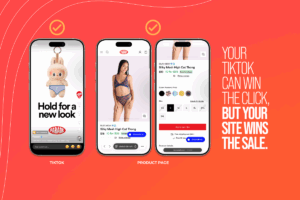
The scenario: A TikTok campaign takes off. Shoppers click “learn more” and land on a dated, clunky site. Trust dips, tabs close, sales vanish.
Why it matters: Your site isn’t a backup, it’s the sales engine. Even if checkout happens in-app, shoppers use your site to validate your brand, see the collection, and check reviews.
What to do:
- Match the visual story – Use the same hero images, video clips, and product angles featured in your TikTok/IG content on your product detail page so buyers instantly recognize what they clicked on. Example: if your ad shows a model wearing a specific color variant, make that color the default selection on the PDP.
- Keep the click-to-buy path under three steps – From the social ad or shop listing, users should land directly on the product page with an “Add to Cart” button visible without scrolling. If they can’t buy in 2–3 taps, you’re losing them.
- Standardize product information – Titles, descriptions, and prices must match exactly between social listings and your site to avoid confusion or mistrust. Even small differences (“Crewneck Tee – Blue” vs. “Blue Cotton Tee”) can make a shopper think it’s a different item.
- Cut distractions in checkout – Remove unnecessary form fields, upsell popups, or unrelated banners that pull buyers away from completing the purchase. The moment someone is in checkout, the only goal is payment completion.
2. Product Pages That Don’t Sell
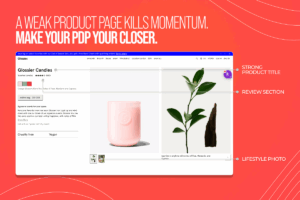
The scenario: Social creative is polished. The PDP isn’t. Blurry photos, vague copy, no urgency, and the momentum… dies.
Why it matters: The PDP is the closer. If it doesn’t instill confidence, the buyer walks.
What to do:
- Lead with scroll-stopping visuals that match your social tone – If your TikTok ad uses a high-energy, close-up product demo, make that same clip (or a high-res still from it) the first thing shoppers see on your PDP. Use tall, mobile-friendly images or videos so it feels native to the experience they just had on social.
- Answer every pre-purchase question directly on the PDP – Include a sizing chart that’s visible without having to download a PDF, fabric/material details in plain language (“100% organic cotton – breathable, mid-weight”), and estimated shipping times right next to the “Add to Cart” button. Remove the need for buyers to dig through FAQ pages.
- Showcase real customer experiences – Pull in reviews with verified buyer badges, star ratings, and short quotes. Add a customer photo gallery or carousel with real-life usage shots—especially ones that reflect your TikTok/IG audience’s style and lifestyle.
- Use urgency cues that are believable – If you display “Only 3 left,” make sure it’s accurate to avoid mistrust. For seasonal items, highlight “Order by [date] for delivery before [event/holiday].” Consider bundle offers (“Buy 2, get 1 free”) if they genuinely provide value and encourage larger carts.
3. Ignoring Mobile Performance
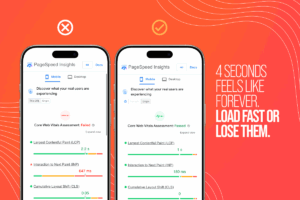
The scenario: A shopper taps through from TikTok. The site takes 4+ seconds to load. Or the add-to-cart button is buried. Bounce.
Why it matters: TikTok and Instagram traffic is mobile-first. If your site isn’t fast, intuitive, and thumb-friendly, you lose.
What to do:
- Audit your site’s mobile speed—aim for under 3 seconds load time – Use tools like Google PageSpeed Insights or GTmetrix to measure load times specifically on 4G mobile. Flag any scripts, apps, or oversized assets slowing things down, and prioritize fixes before your next campaign launch.
- Ensure images and video are compressed but crisp – Save product photos in next-gen formats like WebP or AVIF, and compress them with tools like TinyPNG or ImageOptim. For video, host on a fast CDN or use adaptive streaming so playback starts instantly without quality loss.
- Make CTAs visible without scrolling – On mobile PDPs, the “Add to Cart” or “Buy Now” button should appear above the fold. If you use sticky add-to-cart bars, make sure they don’t block product imagery or other key info.
- Test checkout flow on multiple devices – Run through the purchase process on iPhone, Android, and different browser apps (Safari, Chrome). Look for broken autofill, hidden form fields, or payment method errors that can kill conversions. Bonus: test on low-bandwidth mode to mimic less-than-perfect connections common on mobile networks.
4. One-Size-Fits-All Messaging
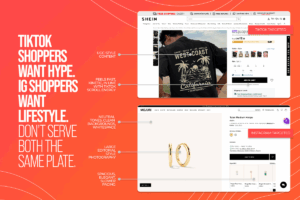
The scenario: TikTok shoppers and Instagram shoppers land on the same PDP. Neither feels spoken to.
Why it matters: TikTok traffic skews impulse-driven and trend-first. Instagram traffic skews curated and lifestyle-led. If your site doesn’t reflect those contexts, you lose momentum.
What to do:
- Carry the tone of your social creative into your PDP and landing pages – If your TikTok creative is high-energy, fun, and trend-driven, your PDP should open with equally punchy headlines, playful copy, and vibrant imagery. If your Instagram ads are more aspirational and lifestyle-led, reflect that with clean layouts, muted color palettes, and editorial-style photography. The goal is for shoppers to feel they’ve stepped into the same “world” they saw in the ad.
- Use platform-specific landing pages to control messaging and flow – Instead of sending all TikTok and IG clicks to the same generic PDP, create unique landing pages for each channel. For TikTok, you might lead with quick-hitting benefit statements, a short demo video, and a one-step checkout option. For Instagram, you might open with a lifestyle hero image, a brand story snippet, and curated product pairings. Use UTM parameters to track performance separately.
- Keep your brand voice consistent but adaptable – Maintain your core personality (e.g., witty, premium, or approachable) across all touchpoints, but adjust the rhythm and emphasis to match the platform’s audience. This prevents jarring tone shifts while still honoring the nuances of TikTok’s casual culture vs. Instagram’s more polished vibe.
5. No Plan for the “Not Now” Shopper
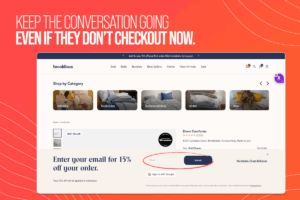
The scenario: Someone browses but doesn’t buy. No retargeting. No follow-up. That warm lead goes cold.
Why it matters: Most shoppers don’t convert on the first visit. Without a re-engagement plan, you lose them for good.
What to do:
- Add a simple, relevant email or SMS opt-in on high-traffic pages – Place sign-up prompts on your homepage, PDPs, and in-cart pages. Keep the offer tied to the shopper’s intent (e.g., “Get 10% off this order” or “Be first to know when this style restocks”). Make sure the form is mobile-friendly, with minimal required fields to avoid drop-off.
- Use exit-intent popups with an offer to stay connected – Trigger a popup when a user’s cursor moves toward closing the page (desktop) or when they scroll quickly upward (mobile). Use urgency-driven copy like “Before you go… your 10% off code is inside” or “Don’t miss your size—join the waitlist now.”
- Run retargeting ads showing the exact product they viewed – Sync your product feed with Meta Ads Manager and TikTok Ads Manager to dynamically serve ads featuring the exact SKU they clicked on. Layer in a sweetener (free shipping, limited-time discount) for those who didn’t convert within 48–72 hours.
- Send timely follow-up emails with social proof or an incentive to return – Within 24 hours of the visit, send an email highlighting customer reviews, user-generated photos, or press mentions of the product they browsed. Follow up with a second reminder email 2–3 days later featuring an offer or countdown timer if applicable.
The Pattern We’ve Seen Over and Over
After 500+ Shopify builds and audits, one thing is clear: social shops drive reach, but your site closes the sale. It’s where trust is built, objections are answered, and lifetime value is created.
The brands that win on TikTok and IG Shop don’t just invest in social, they’re relentless about site optimization.
Quick “Health Check” Questions
Ask yourself:
- Does my site load in under 3 seconds on mobile?
- Are my product pages as persuasive as my best social content?
- Does the site feel like the same brand my customers saw on TikTok or IG?
- Do I have a plan for visitors who don’t buy today?
If you can’t confidently say “yes” to all four, you have work to do before your next campaign.
Bottom line: Social media drives the clicks. Your site closes the sale. Neglect one, and the other can’t save you.
This is All Doable, but You Have to Start Now
If you’re hoping to drive meaningful Q4 sales, your window is now. Waiting until October means fighting for developer time, ad inventory, and customer attention when every other brand is also doing the same thing.
That’s why we built the End-of-Year Readiness Review. It’s explicitly designed for social-first brands with traffic momentum but conversion gaps.
Here’s what it includes:
- A 15-minute intake form to understand your goals and pain points
- A full review of your Shopify store and TikTok/IG Shop integrations
- A live strategy session with one of our conversion specialists
- An implementation-ready checklist (for your team—or ours)
If you want this Q4 to be different, now’s the time to fix what’s holding you back.
Buy Yours Now.




